
Lucion utilises the UK’s largest asbestos testing and inspection facility. Our in-house laboratory is UKAS ISO 17025 accredited for asbestos in soils identification, analysis and quantification using Scanning Electron Microscopy (SEM).


Ensure your teams know the dangers of construction dust and what control measures and protection are required to manage the risks with this quick Toolbox Talk.
_1.png)
Download From NexGen

As part of Lucion’s Take Care Be Aware initiative, we actively take care of our health and safety responsibilities, with continuous awareness of our commitments to knowledge share and educate.
In doing so we have created a ‘toolbox talk’ on asbestos awareness to raise awareness of the hazards associated with asbestos-containing materials, enabling safety professionals to share knowledge and overall save the time and effort in producing them for you and your teams.
_2.png)
Download From NexGen

Does your team know what to do in the event that they find asbestos? Use our simple asbestos discovery flowchart to inform your teams about what to do when suspected asbestos is discovered.
Download Now
Asbestos and other hazardous materials can find its way into made ground and soils in many different circumstances. These include the historic demolition of buildings containing Asbestos Containing Materials (ACMs), fly-tipped waste, the nature of the business that may have previously occupied a site and previously ineffective remediation of areas that may have been suspected as being contaminated.
Asbestos in soil may be found in various forms such as loose fill, insulation, lagging, asbestos insulating board (AIB), cement etc and in some cases asbestos fibres may not visible to the naked eye but can still pose a risk to individuals in the surrounding area and can be transferred if left untreated.
Asbestos in made ground and soils is predominantly immobile, although when contaminated ground soil is disturbed, fibres are more likely to be released and pose a risk to both individuals and the environment.
In traditional building surveys, there is no requirement to undertake a quantitative assessment for asbestos, with regulations instead focusing on the type of Asbestos Containing Material in use rather than the percentage content of asbestos.
However, for those involved in contaminated land projects, there are many legal and regulatory obligations that need to be considered in relation to the potential asbestos contamination of soils and made ground. Control of Asbestos Regulations 2012: Interpretation for Managing and Working with Asbestos in Soil and Construction & Demolition materials: Industry Guidance (also known as CAR-SOIL) requires employers to assess any potential exposure to asbestos faced by employees. Environment Agency regulations require the quantification of asbestos in soils is determined so that an assessment can be made in relation to hazardous waste handling arrangements and human health risk assessments.
Quantitative measurement of any asbestos included in the soil is a fundamental requirement in relation to occupational exposure and the subsequent determination of the most appropriate removal, disposal or soil re-use arrangements. Many scientific studies have been used to link the quantity of any asbestos present in made ground or soil is a potential risk of allowing airborne fibres to be released during disturbance work, potentially putting both individuals and the environment at risk.
To meet all regulatory requirements, and to ensure that the potential presence of asbestos in soils is assessed in the required manner, soil samples need to be assessed in a formal tiered process to identify if asbestos is present (qualification), in what composition (type determination) and in what quantity (quantification).
The thorough analysis of soil, provides the accurate quantification of any asbestos fibres present as a percentage of the overall mass. This, in turn, can be equated to occupational risk and the practices associated with its removal and disposal or re-use.
Working with the Construction Industry Research and Information Industry Association (CIRIA), we have supported the development of new and practical interactive tools to help groundworkers and other construction site workers manage asbestos-contaminated materials on site.
Our experiences working with CIRIA and achieving UKAS accreditation for Soil Sampling and Scanning Electron Microscopy (SEM) analysis means our environmental consultants can offer a range of contaminated land services, tailored to provide a solution that will help deal with the most complex scenarios in an efficient and cost effective manner. Our range of services include:
What are my responsibilities?
The Control of Asbestos Regulations(2012) require sufficient recorded information to prevent exposures to asbestos.
Recently duty holders, landowners and developers have been found liable for claims, despite compliance with the Control of Asbestos Regulations 2012 and planning requirements. In order to avoid liability, it is imperative that potential risks from asbestos-containing soils during all redevelopment is mitigated.
Our team of Environmental Consultants can help you mitigate the risks of hazardous contaminated land. Working alongside our team of specialist hazardous material surveyors we are able to ensure a best practice approach, from the initial site review and desktop study, through to intrusive site investigation and site remediation.
Our team can help you mitigate the risks of hazardous contaminated land. Our team of specialist hazardous material surveyors are able to ensure a best practice approach, from the initial site review and desktop study, through to intrusive site investigation and testing and site remediation.
Ensure your people and environment are protected from hazardous material risks. Contact our team today. Click 'Make an Enquiry' now or give our team a call on 0345 5040 303.